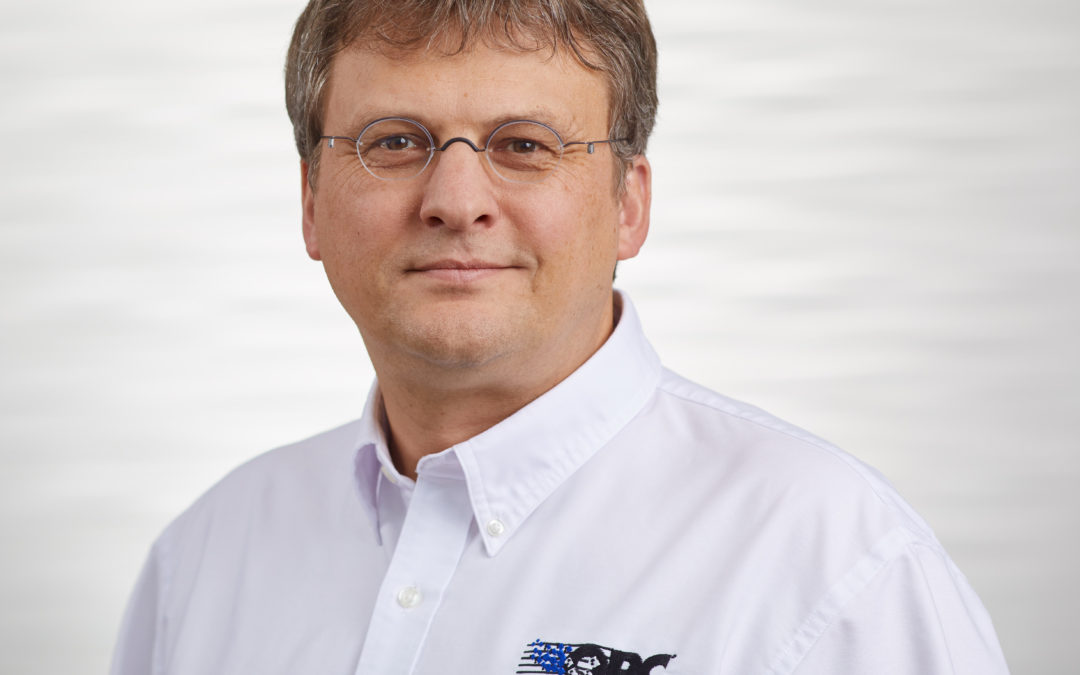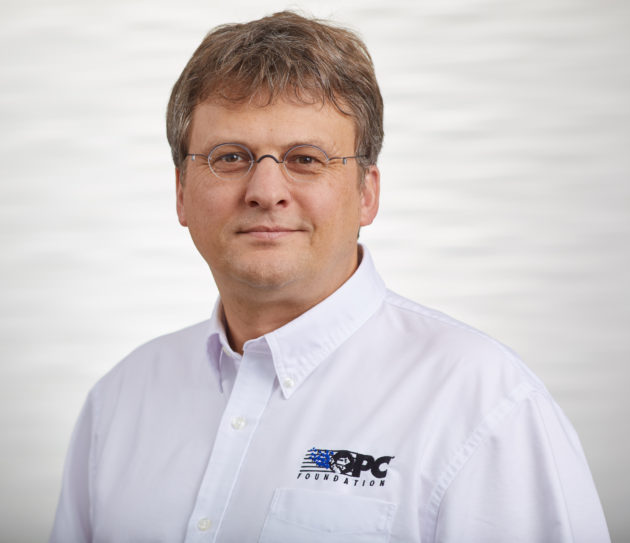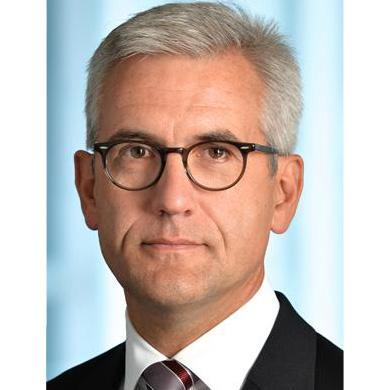
by Gary Mintchell | Oct 31, 2018 | News, Organizations
Tom Burke stepped down as President and Executive Director of the OPC Foundation after 23 years of leadership. He will remain on the Board of Directors continuing his global evangelization for the standard.

Stefan Hoppe, currently a vice president of the organization, becomes the new President and Executive Director. This follows on the recent news that the Board created a new Chair position and elected Veronika Schmid-Lutz of SAP to that position.

Hoppe is a familiar face in the community through his work as VP of Marketing for the past four years.
He joined BECKHOFF in 1995 where he developed OPC classic server and in 2006 the first OPC UA server integrated into an embedded controller. In 2008 he initiated and chaired the PLCopen OPC UA Companion working group. In 2010 Mr. Hoppe was elected President of OPC Foundation Europe. Since 2014, he is Vice President of the OPC Foundation and member of the OPC Board.
Hoppe said “It is truly an honor to be entrusted with the responsibility and exciting opportunity to lead this incredible global organization towards its full potential. While the OPC Foundation roots come from industrial automation and will always be grounded there, I believe it is our duty to greatly widen our horizons in multiple directions – inside industrial automation but also into other new markets.“
On the future adoption of the OPC technology Mr. Hoppe continued, “the value of the open, secure, vendor independent data interoperability the OPC UA standard introduces is universal and is as important to IoT applications across all markets as Ethernet was to connect computers and is to the Internet. My mission is to position and grow the OPC Foundation to work on this scale.”
Elaborating on his decision to change roles, Burke said, “After an amazing 23 years, I have decided it is time to turn over the reins of the day-to-day operations as the President and Executive Director of the OPC Foundation to the next generation. I believe Stefan Hoppe is the right person for this job as he has clearly demonstrated his commitment and strong leadership on many occasions. I look forward to him advancing the OPC Foundation and its OPC UA technology.”
Hoppe concluded “On behalf of the OPC Foundation I sincerely thank Thomas Burke for the vision, leadership, and tireless evangelism he provided all these years. It was great to work with Thomas Burke for the last 8 years and I appreciate his decision to continue his worldwide OPC UA evangelization and contribution of his deep valued insights and strategic advice.”
I am not surprised by the changes. I’ve worked closely with Tom for many years. I’ve also known Stefan since his days at Beckhoff Automation. His presentations for OPC UA have increasingly become less German-centric remaining a powerful statement of the value of standards for the successful implementation of Industry 4.0 and Digital Transformation.
I view this transition as a classic move from the entrepreneur to management. In the end it will be a positive step for the organization. I wish them all well.

by Gary Mintchell | Sep 28, 2018 | Automation, Commentary, News, Software
Dreamforce, the Salesforce annual customer conference, was this week in San Francisco. I should have been there. Along with 100,000 of my closest IT friends. But, my project hit a crisis and I didn’t travel. All is not lost, however, since I received this information about ABB and Salesforce partnering.
The first item of interest is that I went to Salesforce’s “small” summer conference in Chicago with 3x-5x the attendees of a typical industrial technology conference. Then there is the big one with 30x or more the size. It blows the mind.
Then I consider the strategic moves that the largest industrial players are making. Siemens nailed a couple of acquisitions to bolster its MindSphere IoT platform. Schneider takes a majority stake in AVEVA to integrate design to process. ABB aligns with Salesforce (see below). And Rockwell Automation spends major dollars for a small stake in PTC evidently for a tighter integration with ThingWorx and Kepware.
Although there was a lot of marketing buzz to sort through, what ABB gets with a partnership with Salesforce is substantial. The company under the leadership of Ulrich Spiesshofer for the past five years has staged a remarkable turnaround. Don’t forget it also bolstered its machine control / discrete manufacturing portfolio with the acquisition of B+R Automation.
You can see more by watching this Fireside Chat with ABB CEO Ulrich Spiesshofer and Salesforce chairman and co-CEO Marc Benioff on the future of work and Fourth Industrial Revolution.
The stated objective of the partnership is for Salesforce to provide a single view of customers across ABB’s global sales, service and marketing operations.
The partnership will combine the power of Salesforce IoT, Einstein artificial intelligence, and ABB Ability, the cross-industry digital offering supporting an installed base of 70 million connected devices worldwide, to drive enhanced service and faster solutions for customers
Explaining Industry 4.0, otherwise known as The Fourth Industrial Revolution, Salesforce states it is a wave of innovation and technology that is radically transforming every business and industry. It’s no longer enough for manufacturers to differentiate on product—they must also predict customer needs and deliver smarter, more personalized customer experiences. With Salesforce, ABB is unifying its CRM globally, across every region, brand and department, to embrace the opportunities created by the Fourth Industrial Revolution and help its customers pursue important, new openings for service, innovation and growth.
“The Fourth Industrial Revolution is creating massive opportunities for our customers, making the work we do with them to drive innovation and create value more important than ever,” said Ulrich Spiesshofer, CEO of ABB. “That’s why we’re growing our relationship with Salesforce. The wealth of information we’ll get by unifying our data on Salesforce and combining it with our ABB Ability digital offering will allow us to use artificial intelligence and IoT more effectively, so we can anticipate our customer’s needs and write the future together.”
“ABB is undergoing incredible digital transformation and connecting with their customers in revolutionary ways,” said Marc Benioff, Chairman and co-CEO of Salesforce. “Our relationship with ABB is another example of the extraordinary power of artificial intelligence and IoT technologies to drive customer success.”
ABB’s expansion of Salesforce includes Einstein, Salesforce IoT, Sales Cloud, Service Cloud, Marketing Cloud, Community Cloud and Success Cloud advisory services.
Einstein will enable ABB to drive smarter sales and service with artificial intelligence. For example, ABB will use Sales Cloud Einstein for intelligence-driven decision making, automated data entry, identification of potential opportunities and predictive forecasting. Einstein Vision, used with Service Cloud Field Service Lightning, will be used to give ABB’s 15,000 field service technicians the ability to take a photo of an ABB product or component when they arrive onsite to automatically surface information about the product on their screens, resulting in faster, more accurate service.
Salesforce IoT will allow ABB to make data from its connected devices actionable and measurable. The company’s vision is to combine Salesforce IoT with ABB Ability so that its installed base of 70 million connected devices can use predictive intelligence, powered by Einstein, to generate and trigger actions directly into Salesforce. With Salesforce IoT and ABB Ability together, ABB will be able to improve customer experiences by getting ahead of performance and maintenance needs.

by Gary Mintchell | Jul 23, 2018 | Commentary, News
Most companies think they lead their Industry 4.0 competitors in AI and robotic technologies. This sounds like Garrison Keillor describing the mythic village of Lake Wobegon, MN where “all the children are above average.” I’m finding increased interest in digital manufacturing, Industry 4.0, smart manufacturing, or whatever the initiative is called locally.
As always, hype exceeds reality until that point in time when we suddenly realize that everyone is doing it rather than talking about it. Cloud computing falls into that category.
A huge confidence gap exists between the number of companies that try digital manufacturing strategies and those that successfully apply them, a new McKinsey & Co. survey found. In the 2018 Manufacturing Global Expert Survey, 92 percent of respondents think they lead or are on par with competitors in Industry 4.0 manufacturing strategies.
The survey consisted of 700 companies in seven nations. Each had at least 50 employees and $10 million in annual revenue. It found that two-thirds rank digitizing the production value chain as a top priority. Industry 4.0 pursuits fall in three areas:
Connectivity – Using digital performance management and augmented reality to move the right information to the right people in real time. These tactics help communicate interactive work instructions and standard operating procedures.
Intelligence – Advanced analytics and artificial intelligence are fostering better decision making. Examples: Predictive maintenance; digital quality management and AI-driven demand forecasting.
Flexible Automation – New robotic technologies are safer and improve productivity. Human-machine interactive “cobots” and driverless guided vehicles are changing life on the factory floor.
“Despite this focus and enthusiasm, companies are experiencing ‘pilot purgatory.,’ They have significant activities underway. But they are not seeing meaningful bottom-line results,” said Richard Kelly, a McKinsey partner.
China, India and the United States think they lead their competition in digital manufacturing. Japan was an outlier. Its view for the potential of digital manufacturing dropped from over 90 percent in 2017 to 75 percent. Japan’s loss of enthusiasm was far greater than declines in the other three countries. Even so, the success in implementing Industry 4.0 solutions rose significantly in Japan, China and the U.S. while stagnating in Germany.
Digital manufacturing topped the operations-strategy agenda at 68 percent of companies. India led China and Brazil in setting an Industry 4.0 agenda. At 63 percent, the U.S. was 5 percentage points below the 68 percent average.
Companies are piloting an average of eight different Industry 4.0 solutions. India leads with 10.6 digital pilots. China had 10.2 and Brazil had 8.9. The U.S. was fourth at 8.5.
“The challenge is to roll out successful pilot projects to the entire organization,” Kelly said. “That’s what makes transformation happen.”
Across business sectors, connectivity, intelligence and flexible automation solutions showed relevance. Pilots under way trailed that sentiment by 16 to 19 points.
A bigger drop off came when comparing pilot programs in the three areas with those that made it to scale. Only 30 percent rolled out companywide. Industrial automation, software and semiconductors fared best. Healthcare, automotive components and paper and packaging trailed.
In Germany, the U.S., Japan and China, optimism toward digital manufacturing fell after an all-time high in 2017.
“It is quite possible companies still believe in the potential of the various technologies of Industry 4.0,” Kelly said. “But pilot purgatory has been demoralizing. Many are less hopeful about their individual chances of reaping benefits at scale. But we’re seeing great success in the number pilot projects being launched, and the general attitude toward digital manufacturing is quite positive.”

by Gary Mintchell | Jul 10, 2018 | Automation, Commentary
Rockwell Automation’s recent huge investment in PTC for only 8% of the company has sparked a number of thoughts on strategies not only of Rockwell Automation, but also other companies in the market. We’re looking not only at Rockwell Automation in this brief analysis, but also Siemens, Schneider Electric, and ABB.
I’ve left out Emerson, Honeywell, and Yokogawa. The only interesting thing in that part of the market is Emerson’s abortive run at acquiring Rockwell. That was strange. I don’t think that Emerson could have digested such a meal.
The analysis is not to knock anyone but to look for trends and strategies of some of our major suppliers.
I think it begins with Siemens. An executive explained the company’s digital factory strategy and vision many years ago. Then the company acquired UGS and added PLM, CAD, and other digital technologies. There followed other similar acquisitions. I’m thinking mainly of the COMOS product, here.
If you are looking for an articulation of the strategy, I suggest looking no further than Industrie 4.0 and cyber-physical systems.
Sticking with Europe and the competition over there, let’s consider Schneider Electric. This company has been building the “electrification” side of the business which also brought industrial control products and some automation–think Modicon. While it lost considerable market share in PLCs, it did remain in the market. Then it acquired Invensys adding a lot of software (something it never really was good at) but especially process control (Foxboro, etc.). This latter helps it in the power market segment and positions it well against ABB. Siemens of course is the main competitive target. Then is a strange move, Schneider used its software businesses (Wonderware, etc.) as an investment in AVEVA grabbing 51% of the company. Now it, too, has a digital factory strategy in place.
ABB, a strong competitor in the power side of the business and also in process control, acquired B+R Automation. That company was a strong second-tier machine automation supplier fleshing out ABB’s portfolio in the discrete, or machine, automation market. Then it acquired GE’s industrial business strengthening ABB in the “electrification” market. Sounding familiar.
Now look at Rockwell’s investment. That company has flirted with Dassault Systemes over many years for a PLM-to-Control strategy. But nothing ever came of it.
A couple of years ago it acquired thin-client manufacturer ACP and systems integrator Maverick Technologies and MagneMotion a supplier of motion control and conveyor technologies. Then came a large investment in PTC for a small percentage of the company. I speculated that this could be a Digital Factory play along with the respected analyst Joe Barkai, but my friend Keith Larson writing for Putman Publishing (and someone I trust to accurately report on what suppliers are saying) reported that the sought-after prize was a closer integration with ThingWorx. This would be a piece of the Rockwell strategy of “Connected Enterprise” and Larson reported that the target RA product is its MES offering.
In other words, Rockwell Automation seems focused not on the current buzz of Industry 4.0/Industrial Internet of Things/Cyberphysical systems/Digital Factory, but on “making our customers more productive.” Its roots are plant floor and it remains a plant floor supplier.
I am NOT predicting any acquisition of Rockwell Automation, but I do believe that the market needs some continued consolidation. The next five years will be interesting in this market.

by Gary Mintchell | May 21, 2018 | Internet of Things, Manufacturing IT, Software
Hannover Messe was the place to learn the latest about all things digital—digital twin, Industry 4.0, Industrial Internet of Things (IIoT). SAP was one of the many stops in my itinerary advancing the trend.
My contact at the SAP booth at Hannover wasn’t around when I arrived for my appointment, so I left—only to get a text a half-hour later that he had arrived. But I was off to another appointment by then. However I did glean this information from the company at and following the show.
SAP enters the digital twin era
SAP SE has introduced SAP S/4HANA Cloud for intelligent product design, a new solution for collaborative research and development.
The solution, which is built on SAP Cloud Platform using SAP’s latest digital twin technology, is one of the building blocks for a network of digital twins to enable new business models.
Powered by SAP Leonardo and integrated with business processes in the digital core, SAP S/4HANA Cloud for intelligent product design enables customers to accelerate product design and development with requirement-driven systems engineering and instant collaboration across an extended network of suppliers and partners.
“The solution provides shared views of digital twin information for customers to gain live insights on new products and to store, share and review engineering documents with internal and external participants,” said Bernd Leukert, Member of the Executive Board of SAP SE, Products & Innovation.
SAP’s network of digital twins synchronizes the virtual, physical, conditional, and commercial definitions of assets and products in real time to accelerate innovation, optimize operating performance, predict service requirements, improve diagnostics and enhance decision-making. It enables new levels of collaboration among manufacturers of products, operators of assets, suppliers and service companies. The approach combines digital twins with manufacturing solutions from SAP, cloud networks and SAP Leonardo capabilities, including machine learning, blockchain and Internet of Things (IoT), to optimize the product lifecycle with:
• Digital representation: SAP synchronizes digital twin business data, product information, asset master data and IoT-connected data from both on-premise and cloud solutions enabling companies to represent the world digitally. Solutions including SAP Predictive Engineering Insights, SAP Predictive Maintenance and Service and the SAP 3D Visual Enterprise applications provide access to rich data processing capabilities and live configuration, state, condition and control information.
• Business process: Rich enterprise-grade data processing capabilities allow customers to create, access and update digital twins to support business processes. SAP solutions provide an integrated data model from design, production and maintenance to service, including packaged integration to existing systems for computer-aided design, ERP, and product lifecycle management. Offerings providing end-to-end process support for manufacturers and operators include SAP S/4HANA, the SAP Engineering Control Center integration tool, SAP Hybris Service Cloud solutions, and the SAP Manufacturing Integration and Intelligence and SAP Manufacturing Execution applications.
• Business networks: With leading network offerings such as SAP Ariba solutions, SAP Asset Intelligence Network, and the SAP Distributed Manufacturing application, SAP is uniquely positioned to provide a virtual platform for collaboration on products and assets. The network of digital twins enables secure data access, sharing and governance on a global scale.
• Networks of digital representation: SAP enables twin-to-twin connections in systems within a specific asset and on an asset-to-asset level. SAP solutions such as SAP Asset Intelligence Network provide semantic and industry-standards support in an asset core modeling environment to enable live enrichment during the product or asset lifecycle.
Digital Manufacturing Cloud
SAP Digital Manufacturing Cloud helps companies optimize performance, elevate production quality and efficiency, and ensure worker safety.
Drawing on SAP’s expertise in the Industrial Internet of Things (IIoT), predictive analytics and supply networks, the solution enables manufacturers to deploy Industry 4.0 technologies in the cloud.
The new cloud solution extends and complements the digital manufacturing portfolio of on-premise solutions from SAP and is available in different bundles to serve manufacturers of varying sizes in both discrete and process industries and roles within their respective organizations.
SAP customers can choose from the SAP Digital Manufacturing Cloud solution for execution, which provides all solutions in the manufacturing cloud portfolio, or the SAP Digital Manufacturing Cloud solution for insights, which focuses on performance management and predictive quality.
“Manufacturers in the era of Industry 4.0 require solutions that are intelligent, networked and predictive,” said Leukert. “Our manufacturing cloud solutions help customers take advantage of the Industrial Internet of Things by connecting equipment, people and operations across the extended digital supply chain and tightly integrating manufacturing with business operations.”
SAP Digital Manufacturing Cloud includes the following:
• SAP Digital Manufacturing Cloud for execution: Industry0-enabled shop floor solution features “lot size one” and paperless production capabilities. It integrates business systems with the shop floor, allowing for complete component and material-level visibility for single and global installations.
• SAP Digital Manufacturing Cloud for insights: Centralized, data-driven performance management enables key stakeholders to achieve best-in-class manufacturing performance and operations.
• Predictive quality: This helps manufacturers gain valuable insights to conform to specifications across processes and streamline quality management. It also allows manufacturers to apply predictive algorithms that can reduce losses from defects, deficiencies or variations, and recommend corrective actions.
• Manufacturing network: The network provides a cloud-based collaborative platform integrated with SAP Ariba solutions connecting customers with manufacturing service providers, such as suppliers of 3D and computer numerical control (CNC) printing services, material providers, original equipment manufacturers (OEM) and technical certification companies.
Also at Hannover Messe 2018, SAP announced SAP Connected Worker Safety, a solution designed to reduce risks, costs and protect employees. Information from wearables and other sensor-enabled equipment can help companies react immediately to a hazardous situation or incident while proactively managing worker fatigue and other hazard inducers. Real-time information allows monitoring of compliance at all times against regulatory and other parameters.











